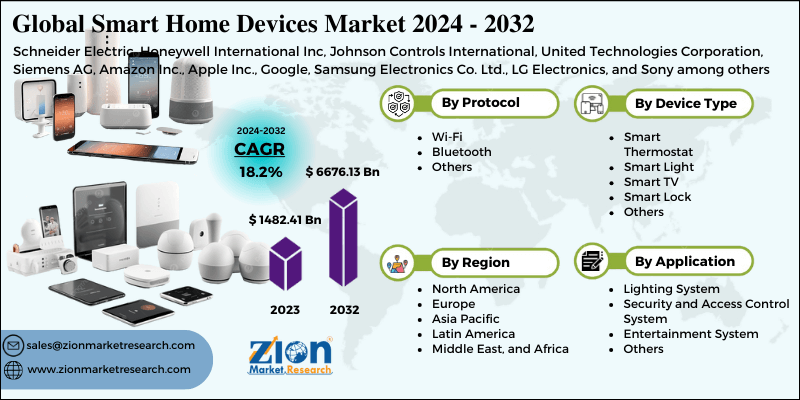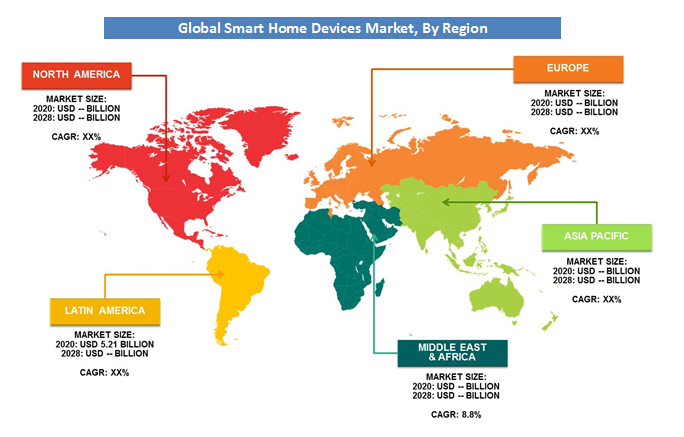Smart Home Devices Market Size, Share, Growth, and Forecast 2032

Smart Home Devices Market by Protocol (Wi-Fi, Bluetooth, and Others), Device Type (Smart Thermostat, Smart Light, Smart TV, Smart Lock, and Others), by Application (Lighting System, Security and Access Control System, Entertainment System, and Others), and By Region - Global and Regional Industry Overview, Market Intelligence, Comprehensive Analysis, Historical Data, and Forecasts 2024 - 2032-
| Market Size in 2023 | Market Forecast in 2032 | CAGR (in %) | Base Year |
|---|---|---|---|
| USD 1482.41 Billion | USD 6676.13 Billion | 18.2% | 2023 |
Smart Home Devices Market Size
Zion Market Research has published a report on the global Smart Home Devices Market, estimating its value at USD 1482.41 Billion in 2023, with projections indicating that it will reach USD 6676.13 Billion by 2032. The market is expected to expand at a compound annual growth rate (CAGR) of 18.2% over the forecast period 2024-2032. The
report explores the factors fueling market growth, the hitches that could hamper this expansion, and the opportunities that may arise in the Smart Home Devices Market industry. Additionally, it offers a detailed analysis of how these elements will affect market demand dynamics and market performance throughout the forecast period.
Smart Home Devices Market Overview
A smart device is an electronic device that can communicate with other devices or networks using various wireless protocols such as Bluetooth, Zigbee, NFC, Wi-Fi, LiFi, and 5G, among others. Smart home devices are connected to each other and can be controlled by using a single central point, such as a smartphone, tablet, desktop, or game console.
The growth of the smart home industry is fueled by a variety of factors, including an increase in internet users, increased adoption of smart devices, rising disposable income in developed economies, and a rise in the need to save energy and decrease carbon emissions.
The recent trends in the smart home devices market focus on artificial intelligence and automation to provide domestic assistance in a new and innovative way while ensuring that all advanced technological tools and security are in place. Face recognition technology, video doorbells, remote-controlled locks, and ultra-modern burglar alarms are some trending security smart home devices.
COVID-19 Impact Analysis
Due to the COVID-19 pandemic, more people started staying at home and making changes in their living environment resulting in the adoption of IoT technology. Stay-at-home directives transformed the way people interacted in their homes, causing them to rearrange their living space to fulfill new functional requirements such as working and studying at home, setting up at-home gyms, and discovering new ways to relax and enjoy themselves.
Smart Home Devices Market: Growth Factors
The market for smart home devices is driven by the growing need to conserve electricity and reduce carbon emissions. Electricity is continually consumed by conventional devices until they are switched off. On the other hand, however, smart home devices are equipped with motion sensors that can sense the absence of people in a room for a specified period of time and switch off automatically, saving money and energy.
The smart home devices market is expected to grow as customers' preferences for video doorbells, voice-assisted devices, and security systems are growing over time. The increased adoption of smartphones due to the proliferation of the internet among the masses is one of the major factors behind consumers' IoT acceptance. As a result of the widespread use of internet-connected smart devices, the overall IoT market is with witness growth.
Smart Home Devices Market: Segmentation
Device Type Segment Analysis Preview
The smart TV segment held a share of around 20% in 2020. This is attributable to the latest innovations in the user interface, content aggregation, and application development that come with smart TVs, such as the operating system that can run apps and widgets, which can stream videos and music. Smart TVs come with unified internet features and a wide range of digital computing and networking capabilities. Consumers can now use smart TVs to search, chat, browse, post, update, and download content. In the coming years, smart TVs are predicted to place a greater emphasis on experience design. The availability of consumption-ready content for consumers to use their smart TVs has been clinical in the demand surge.
Application Segment Analysis Preview
The security and access control system segment will grow at a CAGR of over 12% from 2021 to 2028. This growth can be attributed to the globally rising crime rates driving the smart home security market. Nowadays, customers are placing a greater emphasis on safety and security services, especially in residential areas. Households prefer smart home devices such as smart locks, smart cameras, and smart lockers to be safer and more secure. The advent of the Internet of Things (IoT) and wireless technology, as well as the growing use of IP cameras for video surveillance, are also contributing to the growth. The increasing use of the internet, laptops, and smartphones is paving the way for IoT to be used in home protection through the use of smart applications.
Smart Home Devices Market: Report Scope
| Report Attributes | Report Details |
|---|---|
| Report Name | Smart Home Devices Market |
| Market Size in 2023 | USD 1482.41 Billion |
| Market Forecast in 2032 | USD 6676.13 Billion |
| Growth Rate | CAGR of 18.2% |
| Number of Pages | 130 |
| Key Companies Covered | Schneider Electric, Honeywell International Inc, Johnson Controls International, United Technologies Corporation, Siemens AG, Amazon Inc., Apple Inc., Google, Samsung Electronics Co. Ltd., LG Electronics, and Sony among others |
| Segments Covered | By Protocol, By Device Type, By Application, and By Region |
| Regions Covered | North America, Europe, Asia Pacific (APAC), Latin America, Middle East, and Africa (MEA) |
| Base Year | 2023 |
| Historical Year | 2018 to 2022 |
| Forecast Year | 2024 - 2032 |
| Customization Scope | Avail customized purchase options to meet your exact research needs. Request For Customization |
Smart Home Devices Market: Regional Analysis
The European region held a share of over 22% in 2020. This is attributable to the increasing investments in infrastructure that have been undertaken to improve the standard of living in this region. Increased demand for heating, ventilation, and air conditioning systems coupled with energy management has significantly driven regional growth.
The Asia Pacific region is projected to grow at a CAGR of over 12% during the forecast period. This surge is due to technological advancements that resulted in an increase in the adoption of smart home devices, especially in developing Asian countries, including China, Japan, and India, among others. Rapid digitization, Increasing awareness among consumers, growing need for energy consumption & emissions, and high penetration of smartphones paired with government initiatives such as the establishment of smart cities in countries such as India, Japan, and China are some of the prominent drivers for the growth of smart home devices market in the Asia-Pacific region.
Smart Home Devices Market: Competitive Players
Some of the key players in the smart home devices market are
- Schneider Electric
- Honeywell International Inc
- Johnson Controls International
- United Technologies Corporation
- Siemens AG
- Amazon Inc.
- Apple Inc.
- Google, Samsung Electronics Co. Ltd.
- LG Electronics
- Sony
- Among others
Companies in the smart home technology industry have traditionally used a subscription model, in which users pay a monthly charge for a fixed amount for the services. However, now they are constantly looking at new ways to monetize smart home technologies, such as service bundling, audio advertising, and using IoT data.
Also as the device margins are slowly fading, companies are relying on the stickiness aspect by providing new solutions and value-added services to consumers in addition to device sales.
The global smart home devices market is segmented as follows:
By Protocol
- Wi-Fi
- Bluetooth
- Others
By Device Type
- Smart Thermostat
- Smart Light
- Smart TV
- Smart Lock
- Others
By Application
- Lighting System
- Security and Access Control System
- Entertainment System
- Others
By Region
- North America
- The U.S.
- Canada
- Europe
- France
- The UK
- Spain
- Germany
- Italy
- Rest of Europe
- Asia Pacific
- China
- Japan
- India
- South Korea
- Southeast Asia
- Rest of Asia Pacific
- Latin America
- Brazil
- Mexico
- Rest of Latin America
- Middle East & Africa
- GCC
- South Africa
- Rest of Middle East & Africa
Table Of Content
Methodology
FrequentlyAsked Questions
Smart home devices are internet-connected appliances and systems that enable automation, remote control, and monitoring of household functions. Examples include smart thermostats, lights, security cameras, and voice assistants, enhancing convenience, energy efficiency, and home security.
According to study, the Smart Home Devices Market size was worth around USD 1482.41 billion in 2023 and is predicted to grow to around USD 6676.13 billion by 2032.
The CAGR value of Smart Home Devices Market is expected to be around 18.2% during 2024-2032.
European region has been leading the Smart Home Devices Market and is anticipated to continue on the dominant position in the years to come.
The Smart Home Devices Market is led by players like Schneider Electric, Honeywell International Inc, Johnson Controls International, United Technologies Corporation, Siemens AG, Amazon Inc., Apple Inc., Google, Samsung Electronics Co. Ltd., LG Electronics, Sony, and among others.
HappyClients
Zion Market Research
Tel: +1 (302) 444-0166
USA/Canada Toll Free No.+1 (855) 465-4651
3rd Floor,
Mrunal Paradise, Opp Maharaja Hotel,
Pimple Gurav, Pune 411061,
Maharashtra, India
Phone No +91 7768 006 007, +91 7768 006 008
US OFFICE NO +1 (302) 444-0166
US/CAN TOLL FREE +1 (855) 465-4651
Email: sales@zionmarketresearch.com
We have secured system to process your transaction.
Our support available to help you 24 hours a day, five days a week.
Monday - Friday: 9AM - 6PM
Saturday - Sunday: Closed








